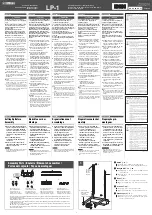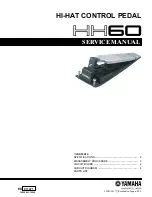
The BIGSBY Pedal's main controls consist of three backlit rotary knobs and the SELECT button.
The knobs on the pedal’s front panel have two “layers”: the WHITE layer and the RED layer.
To toggle between the WHITE and RED layers - press the SELECT button.
RATE
When the RATE knob is turned all the way down (the knob is dark), the BIGSBY Pedal’s
pitch-shift algorithm precisely follows the movement of the foot-pedal, and stays static for as
long as the pedal is pressed down.
Turning up RATE will put BIGSBY Pedal into “Auto Mode”, and the knob will start flashing.
In Auto Mode the pitch shift depth oscillates rhythmically at a given speed, while the maximum
depth of the pitch-shift is determined by the amount of pressure applied to the foot-pedal.
Adjust the RATE knob to change the speed of the vibrato effect.
When in Auto Mode, turning up the BLEND knob will produce a chorus-style effect.
When using MIDI, the BIGSBY Pedal can be synced to an external clock source (see page 6).
In this case, the RATE knob lets you scroll through a variety of beat subdivisions. There is also a
dedicated CC message for adjusting the offset of the vibrato curve.
DETUNE
The BIGSBY’s DETUNE function emulates the instability and asymmetrical nature of traditional
hardware tremolo systems.
When the DETUNE knob is turned all the way down, the BIGSBY will produce even pitch-shifts.
When DETUNE is turned all the way up, chords will have the familiar “out of tune” effect -
a characteristic of mechanical string bending systems. Single notes will also sound “out of tune”
and “warbly”.
DEPTH
The BIGSBY Pedal’s DEPTH knob allows you to set different values for the downward and
upward pitch-shift intervals.
Press the SELECT button to enter the RED layer, which is indicated by a red backlight on the
pedal’s knobs. Use the DEPTH knob to set the desired upward pitch-shift value.
Toggling the INVERT switch on the pedal’s back panel will only affect the foot-pedal’s direction -
the DEPTH values set up for both downward and upward pitch-shifting will remain set.
TONE
The TONE knob adjusts the brightness of the WET signal produced by the BIGSBY Pedal.
The DRY (unpitched) signal is not affected by the TONE control.
When the TONE knob is turned all the way down the WET signal will have a muffled, dark
character - this is well-suited for imitating lower register instruments.
Turn the TONE knob all the way up to boost the WET signal’s high frequencies -
thus highlighting note attacks and overall string brightness.
KNOB LOCK
The BIGSBY Pedal's knobs can be temporarily locked in order
to prevent accidental adjustments during a live performance etc.
To lock the current knob settings, hold the SELECT
button and toggle the INVERT switch on the back of the pedal.
When the pedal is locked, all knob adjustments will be ignored, which will be indicated by
flickering knobs.
The SELECT button will still function as a toggle between the WHITE and RED knob layers.
To unlock the knobs, toggle the INVERT switch to it’s original position.
4


























